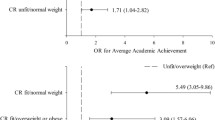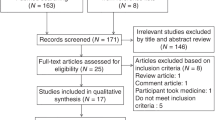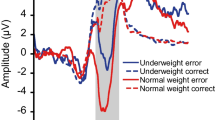Abstract
Eating disorders (ED) can arise from a combination of biological and psychological factors. Some studies suggest that intellectual factors might be important in the development of ED, although the evidence is still scarce. The aim of this study was to examine the association between cognition measurements (cognitive performance and academic achievement) and the risk of developing ED in adolescents considering their weight status. The sample consisted of 3,307 adolescents (1,756 girls), aged 13–18.5 years, who participated in the AVENA (n = 1,430; 783 girls) and AFINOS (n = 1,877; 973 girls) studies. Cognitive performance was measured by the TEA test in the AVENA study, and academic achievement was self-reported in the AFINOS study. ED risk was evaluated in both studies by using the SCOFF questionnaire. Body mass index was calculated to classify adolescents as non-overweight or overweight (including obesity). Overweight adolescents showed a higher risk of developing ED than non-overweight ones in both studies. In the AVENA study, overweight boys with low performance in reasoning ability showed increased risk of ED (p = 0.05). In the AFINOS study, overweight boys with low academic performance in physical education and non-overweight girls with low academic achievement in all the areas analyzed showed higher risk of ED than their peers (all p < 0.05). Conclusion: No association between cognitive performance and ED risk was found in adolescents, while academic achievement was associated with ED risk, especially in non-overweight girls. The non-cognitive traits that accompany academic achievement could influence the likelihood of developing ED in these girls.

Similar content being viewed by others
References
Bar-Or O (1993) Physical activity and physical training in childhood obesity. J Sports Med Phys Fitness 33:323–711
Bernstein A, Penner LA, Clarke-Stewart A et al (2003) Psychology (6th edn). Houghton Miin, Boston
Brolin S, Modin B (2012) School-performance indicators and subjective health complaints: are there gender differences? Sociol Health Ill 34:608–625. doi:10.1111/j.1467-9566.2011.01395.x
Chui HT, Christensen BK, Zipursky RB et al (2008) Cognitive function and brain structure in females with a history of adolescent-onset anorexia nervosa. Pediatrics 122:426–37. doi:10.1542/peds.2008-0170
Cole TJ, Bellizzi MC, Flegal KM et al (2000) Establishing a standard definition for child overweight and obesity worldwide. BMJ 320:1240–43
Croll J, Neumark-Sztainer D, Story M et al (2002) Prevalence and risk and protective factors related to disordered eating behaviors among adolescents: relationship to gender and ethnicity. J Adolesc Health 31:166–75
Dalle R (2011) Eating disorders: progress and challenges. Eur J Intern Med 22:153–60. doi:10.1016/j.ejim.2010.12.010
Deary I, Strand S, Smith P et al (2007) Intelligence and educational achievement. Intelligence 35:13–21
Gil García E, Ortiz Gómez T, Fernández Soto ML (2007) Social profiles, diet, and prediction of eating disorders in urban Andalusian adolescents. Atencion primaria/Sociedad Española de Medicina de Familia y Comunitaria 39:7–11
González-Gross M, Castillo MJ, Moreno L et al (2003) Feeding and assessment of nutritional status of Spanish adolescents (AVENA study). Evaluation of risks and interventional proposal. Methodology. Nutr Hosp 18:15–28
Herpertz-Dahlmann B (2009) Adolescent eating disorders: definitions, symptomatology, epidemiology and comorbidity. Child Adolesc Psychiatr Clin N Am 18:31–47. doi:10.1016/j.chc.2008.07.005
Huas C, Godart N, Caille A et al (2013) Mortality and its predictors in severe bulimia nervosa patients. Eur Eat Disord Rev 21:15–19. doi:10.1002/erv.2178
Kamijo K, Khan NA, Pontifex MB et al (2012) The relation of adiposity to cognitive control and scholastic achievement in preadolescent children. Obesity (Silver Spring) 20:2406–2411. doi:10.1038/oby.2012.112
Koyama KI, Asakawa A, Nakahara T et al (2012) Intelligence quotient and cognitive functions in severe restricting-type anorexia nervosa before and after weight gain. Nutrition 28:1132–1136. doi:10.1016/j.nut.2012.03.003
Lahortiga-Ramos F, De Irala-Estévez J, Cano-Prous A et al (2005) Incidence of eating disorders in Navarra (Spain). Eur Psychiatry 20:179–185
Lee HJ, Park S, Ci K et al (2013) The association between disturbed eating behavior and socioeconomic status: the Online Korean Adolescent Panel Survey (OnKAPS). PLoS One 8:e57880. doi:10.1371/journal.pone.0057880
Lena SM, Fiocco AJ, Leyenaar JK (2004) The role of cognitive deficits in the development of eating disorders. Neuropsychol Rev 14:99–113
Liang J, Matheson BE, Kaye WH, et al (2013) Neurocognitive correlates of obesity and obesity-related behaviors in children and adolescents. Int J Obes (Lond) 5. doi: 10.1038/ijo.2013.142
Livazovic G, Rucevic S (2010) Externalizing behaviors and eating disorder risk factors in adolescents. Drustvena Istrazivanja 21:733–752
Martínez-Gómez D, Veiga OL, Gómez-Martínez S et al (2012) Gender-specific influence of health behaviors on academic performance in Spanish adolescents; the AFINOS study. Nutr Hosp 27:724–730. doi:10.3305/nh.2012.27.3.5633
Mischoulon D, Eddy KT, Keshaviah A et al (2011) Depression and eating disorders: treatment and course. J Affect Disord 130:470–77. doi:10.1016/j.jad.2010.10.043
Moreno LA, Joyanes M, Mesana MI et al (2003) Harmonization of anthropometric measurements for a multicenter nutrition survey in Spanish adolescents. Nutrition 19:481–6
Morgan JF, Reid F, Lacey JH (1999) The SCOFF questionnaire: assessment of a new screening tool for eating disorder. BMJ 319:1467–68
O’Connor M, Paunonen S (2007) Big five personality predictors of post-secondary academic performance. Personal Individ Differ 43:971–990. doi:10.1016/j.paid.2007.03.017
Obeid N, Buchholz A, Boerner KE et al (2013) Self-esteem and social anxiety in an adolescent female eating disorder population: age and diagnostic effects. Eat Disord 21:140–53. doi:10.1080/10640266.2013.761088
Ong LC, Chandran V, Lim YY et al (2010) Factors associated with poor academic achievement among urban primary school children in Malaysia. Singapore Med J 51:247–252
Petrides KV, Chamorro-Premuzic T, Frederickson N et al (2005) Explaining individual differences in scholastic behaviour and achievement. Br J Educ Psychol 75:239–255
Ross S (2010) Motivation correlates of academic achievement: exploring the relationship between motivation and academic achievement in the PISA 2003 dataset. Ph.D. Thesis/Dissertation, University of Victoria, Victoria
Rueda GE, Díaz LA, Ortiz DP et al (2005) Validation of the SCOFF questionnaire for screening the eating behaviour disorders of adolescents in school. Aten Primaria 35:89–94
Smink FR, van Hoeken D, Hoek HW (2012) Epidemiology of eating disorders: incidence, prevalence and mortality rates. Curr Psychiatry Rep 14:406–14. doi:10.1007/s11920-012-0282-y
Steinglass JE, Walsh BT, Stern Y (2006) Set shifting deficit in anorexia nervosa. J Int Neuropsychol Soc 12:431–35
Strand S (2003) Getting the best from CAT: a practical guide for secondary schools. nferNelson, London
Swanson SA, Crow SJ, Le Grange D et al (2011) Prevalence and correlates of eating disorders in adolescents. Results from the national comorbidity survey replication adolescent supplement. Arch Gen Psychiatry 68:714–23. doi:10.1001/archgenpsychiatry.2011.22
Thurstone L, Thurstone T (1958) SRA test of educational ability. Science Research Associates, Chicago
Thurstone L, Thurstone T (1998) TEA Test de Aptitudes Escolares (Scholar Aptitudes Test). Sección de Estudio de Test de Técnicos Especialistas Asociados, Madrid
Veiga OL, Gómez-Martínez S, Martínez-Gómez D et al (2009) Physical activity as a preventive measure against overweight, obesity, infections, allergies and cardiovascular disease risk factors in adolescents: AFINOS Study protocol. BMC Public Health 9:475. doi:10.1186/1471-2458-9-475
Weider S, Indredavik MS, Lydersen S et al (2014) Intellectual function in patients with anorexia nervosa and bulimia nervosa. Eur Eat Disorders Rev 22:15–24
Yanover T (2008) Eating problems, body image disturbances, and academic achievement: preliminary evaluation of the eating and body image disturbances academic interference scale. Int J Eat Disord 41:184–187
Acknowledgments
The authors gratefully acknowledge the adolescents and their parents who participated in this study. The AVENA Study was supported by the Spanish Ministry of Health, FIS (00/0015) and grants from Panrico S.A., Madaus S.A. and Procter & Gamble S.A. The AFINOS Study was supported by grant DEP2006-56184-C03-01-02-03/PREV from the Spanish Ministry of Education and Science and co-funded by FEDER funds from European Union.
Author information
Authors and Affiliations
Corresponding author
Additional information
Communicated by Peter de Winter
Appendices
Appendices
Appendix A. AVENA Study Group
Coordinator: A Marcos, Madrid.
Main investigators: MJ Castillo, Granada. A Marcos, Madrid. S Zamora, Murcia. M García Fuentes, Santander. M Bueno, Zaragoza, Spain.
Granada: MJ Castillo, MD Cano, R Sola (Biochemistry); A Gutiérrez, JL Mesa, J Ruiz (Physical Fitness); M Delgado, P Tercedor, P Chillón (Physical Activity), FB Ortega, M Martín, F Carreño, GV Rodríguez, R Castillo, F Arellano (Collaborators). Universidad de Granada. E-18071 Granada. Madrid: A Marcos, M González-Gross, J Wärnberg, S Medina, F Sánchez Muniz, E Nova, A Montero, B de la Rosa, S Gómez-Martínez, S Samartín, J Romeo, R Álvarez, (Coordination, Immunology) A Álvarez (Cytometric Analysis) L Barrios (Statistical Analysis) A Leyva, B Payá (Psychological Assessment). L Martínez, E Ramos, R Ortiz, A Urzanqui. (Collaborators). Instituto de Nutrición y Bromatología. Consejo Superior de Investigaciones Científicas (CSIC). E-28040 Madrid. Murcia: S Zamora, M Garaulet, F Pérez-Llamas, JC Baraza, JF Marín, F Pérez de Heredia, MA Fernández, C González, R García, C Torralba, E Donat, E Morales, MD García, JA Martínez, JJ Hernández, A Asensio, FJ Plaza, MJ López (Diet Analysis). Dpto. Fisiología. Universidad de Murcia. E-30100 Murcia. Santander: M García Fuentes, D González-Lamuño, P de Rufino, R Pérez-Prieto, D Fernández, T Amigo (Genetic study). Dpto. Pediatría. Universidad de Cantabria. E- 19003 Santander . Zaragoza: M Bueno, LA Moreno, A Sarriá, J Fleta, G Rodríguez, CM Gil, MI Mesana, JA Casajús, V Blay, MG Blay. (Anthropometric Assessment). Escuela Universitaria de Ciencias de la Salud. Universidad de Zaragoza. E-50009 Zaragoza.
Appendix B. AFINOS Study Group
Coordinator: Marcos A
Main Investigators: Calle ME, Villagra A, Marcos A.
Sub-study 1: Calle ME, Regidor E, Martínez-Hernández D, Esteban-Gonzalo L. Department of Preventive Medicine and Public Health, Universidad Complutense de Madrid, E- 28040, Madrid, Spain. Sub-study 2: Villagra A, Veiga OL, del-Campo J, Moya JM, Martínez-Gómez D, Zapatera B. Department of Physical Education, Sport and Human Movement, Facultad de Formación del Profesorado y Educación, Universidad Autonoma de Madrid, E-28049, Madrid, Spain. Sub-study 3: Marcos A, Gómez-Martínez S, Nova E, Wärnberg J, Romeo J, Diaz LE, Pozo T, Puertollano MA, Martínez-Gómez D, Zapatera B, Veses A. Immunonutrition Research Group, Department of Metabolism and Nutrition, Institute of Food Science, Technology and Nutrition (ICTAN), Instituto del Frio, Spanish National Research Council (CSIC), E-28040, Madrid, Spain.
Rights and permissions
About this article
Cite this article
Veses, A.M., Gómez-Martínez, S., de Heredia, F.P. et al. Cognition and the risk of eating disorders in Spanish adolescents: the AVENA and AFINOS studies. Eur J Pediatr 174, 229–236 (2015). https://doi.org/10.1007/s00431-014-2386-3
Received:
Revised:
Accepted:
Published:
Issue Date:
DOI: https://doi.org/10.1007/s00431-014-2386-3




